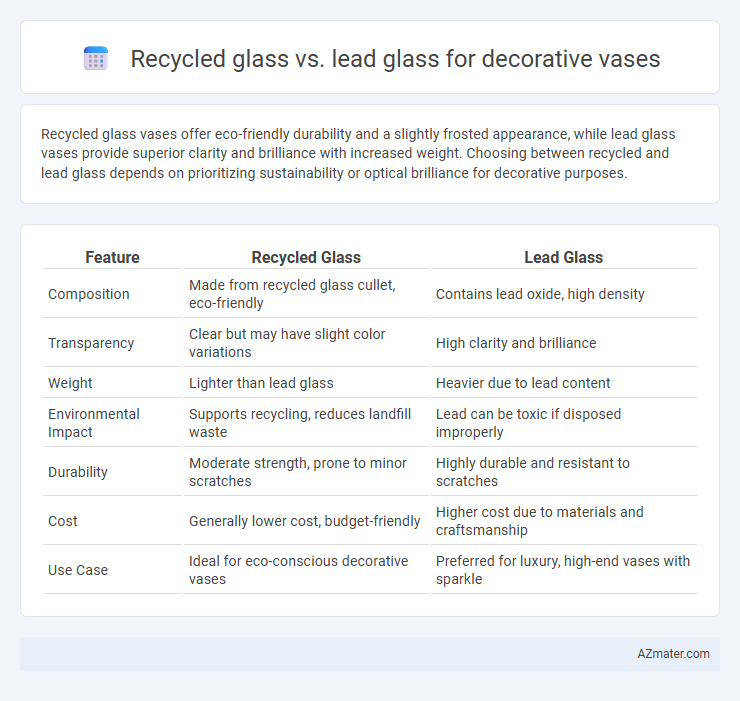Recycled glass vases offer eco-friendly durability and a slightly frosted appearance, while lead glass vases provide superior clarity and brilliance with increased weight. Choosing between recycled and lead glass depends on prioritizing sustainability or optical brilliance for decorative purposes.
Table of Comparison
| Feature | Recycled Glass | Lead Glass |
|---|---|---|
| Composition | Made from recycled glass cullet, eco-friendly | Contains lead oxide, high density |
| Transparency | Clear but may have slight color variations | High clarity and brilliance |
| Weight | Lighter than lead glass | Heavier due to lead content |
| Environmental Impact | Supports recycling, reduces landfill waste | Lead can be toxic if disposed improperly |
| Durability | Moderate strength, prone to minor scratches | Highly durable and resistant to scratches |
| Cost | Generally lower cost, budget-friendly | Higher cost due to materials and craftsmanship |
| Use Case | Ideal for eco-conscious decorative vases | Preferred for luxury, high-end vases with sparkle |
Introduction to Decorative Vases: Material Matters
Decorative vases crafted from recycled glass offer eco-friendly benefits by incorporating sustainable materials that reduce environmental impact, while lead glass vases are prized for their brilliance and clarity due to higher refractive index and lead oxide content. Recycled glass often features unique textures and color variations, enhancing the vase's artisanal appeal and emphasizing sustainability. Lead glass vases provide superior weight and light refraction, making them ideal for high-end decorative pieces that showcase intricate craftsmanship and luxury.
What Is Recycled Glass? Key Characteristics
Recycled glass is made by melting down post-consumer or post-industrial glass waste to create new glass products, reducing raw material consumption and energy use. Its key characteristics include sustainability, lower carbon footprint, and often a slightly textured or frosted appearance due to impurities in the recycled batch. Compared to lead glass, recycled glass typically lacks the high refractive index and brilliance but offers an eco-friendly, cost-effective option for decorative vases.
Understanding Lead Glass: Features & Origins
Lead glass, also known as crystal, contains lead oxide which enhances its clarity, weight, and brilliance, making it a popular choice for decorative vases. Originating from 17th-century England, lead glass production combines traditional craftsmanship with modern techniques to achieve exceptional refractive qualities. Compared to recycled glass, lead glass offers superior light refraction and a luxurious finish but is less environmentally friendly due to lead content and energy-intensive manufacturing.
Environmental Impact: Recycled Glass vs Lead Glass
Recycled glass significantly reduces environmental impact by lowering raw material extraction and energy consumption, cutting greenhouse gas emissions by up to 30% compared to manufacturing new glass. Lead glass, while prized for its clarity and weight, poses environmental hazards due to lead content, which can contaminate soil and water if not properly disposed of or recycled. Choosing recycled glass for decorative vases promotes sustainability by minimizing toxic waste and supporting circular economy principles in glass production.
Aesthetic Differences: Clarity, Color, and Shine
Recycled glass decorative vases often display a natural, muted aesthetic with slight variations in clarity and subtle color shifts due to impurities, giving each piece a unique, rustic charm. Lead glass vases offer exceptional clarity and brilliance, with a high refractive index that produces a dazzling shine, making colors appear more vibrant and light more refracted. The choice between recycled and lead glass impacts the vase's overall visual appeal, where recycled glass emphasizes eco-friendly uniqueness while lead glass prioritizes luminous elegance.
Durability and Longevity Comparison
Recycled glass decorative vases offer moderate durability with resistance to everyday wear but tend to be more prone to chipping compared to lead glass. Lead glass, known for its high lead oxide content (up to 30-35%), provides superior strength, clarity, and extensive longevity, making it less susceptible to damage over time. The inherent density and structural integrity of lead glass ensure that vases maintain their aesthetic appeal and functional durability for decades, outperforming typical recycled glass alternatives.
Health and Safety Considerations
Recycled glass vases eliminate the presence of toxic heavy metals like lead, significantly reducing health risks associated with prolonged exposure, especially in household environments. Lead glass contains lead oxide, which can leach into the air or liquids, posing serious health hazards such as neurological damage and poisoning when used in close contact with food or water. Choosing recycled glass for decorative vases promotes safer indoor air quality and minimizes long-term exposure to harmful contaminants, ensuring a healthier living space.
Cost Efficiency and Market Availability
Recycled glass vases offer significant cost efficiency due to lower raw material expenses and reduced energy consumption during production, making them an economical choice for decorative purposes. Lead glass vases, while often more expensive because of higher material costs and sophisticated manufacturing processes, are prized for their brilliance and clarity. Market availability of recycled glass vases is growing rapidly as sustainability trends increase demand, whereas lead glass remains popular in niche luxury markets with limited but steady supply chains.
Sustainability: Which Material Is Greener?
Recycled glass significantly reduces environmental impact by minimizing raw material extraction and energy consumption, making it a more sustainable choice for decorative vases compared to lead glass. Lead glass, containing lead oxide, poses ecological and health risks during production and disposal, contributing to soil and water contamination. Choosing recycled glass enhances circular economy efforts and lowers carbon footprint, aligning with eco-friendly design principles.
Choosing the Ideal Glass Vase for Your Decor
Recycled glass vases offer eco-friendly, unique textures and a natural color palette that complements sustainable decor while reducing environmental impact. Lead glass vases provide superior clarity, brilliance, and weight, enhancing elegance and light refraction in upscale interior designs. Selecting between recycled and lead glass depends on whether you prioritize sustainability and rustic charm or refined clarity and luxury for your decorative vase.

Infographic: Recycled glass vs Lead glass for Decorative vase
 azmater.com
azmater.com